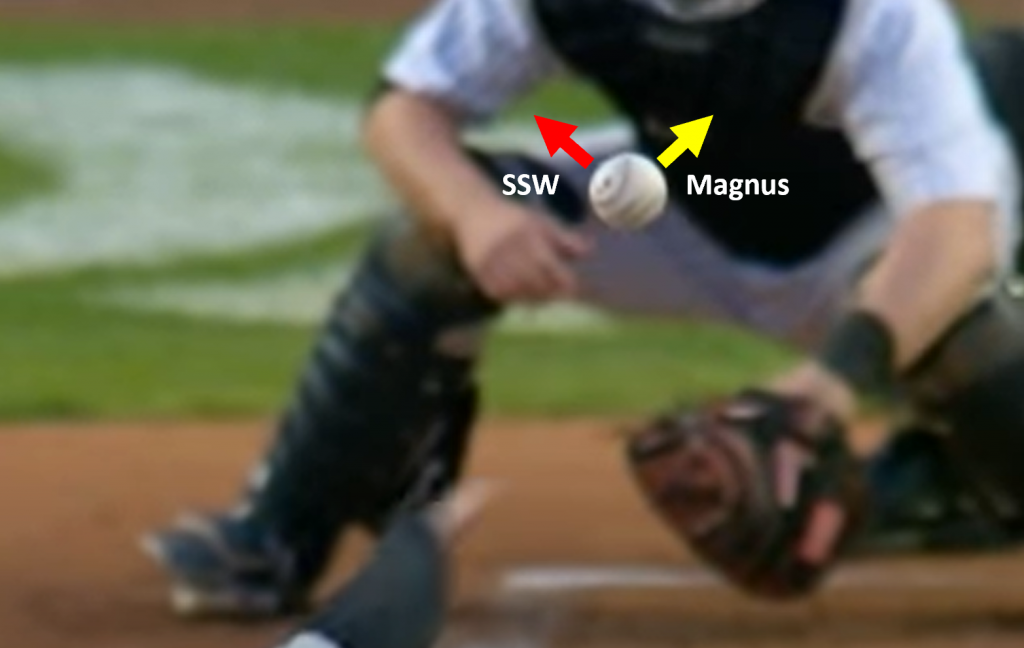For any rational discussion, you have to define "movement." There are two different ways to define movement. "Absolute movement" is the amount of movement a pitch has compared to a pitch with zero rotation and the seams symmetrically oriented (the symmetrical pattern, that is 2-seam or 4-seam, doesn't matter as long as it is symmetrical). "Relative movement" is the amount of movement compared to the other pitches a pitcher throws. Relative movement is much more important than absolute movement, since this relates directly to pitching effectiveness.
Absolute movement of a pitch can come from either (1) the orientation of the spin axis and the spin rate of the ball or (2) throwing a pitch where the seams are asymmetrical in the direction of motion of the ball.
SPIN AXIS & SPIN RATE
The Magnus Effect is a well-established fact. If a ball has a spin axis perpendicular to the direction the ball is thrown and the ball is spinning, the flight path of the ball is different than that of a ball thrown with no spin. https://en.wikipedia.org/wiki/Magnus_effect
The most common Magnus Effect pitches are the drop ball and the "backspin" or "true" riseball.
In pitching, the important factors for absolute movement are (1) the spin rate of the ball and (2) the spin axis. As to spin rate, REV FIRE did studies about spin rate. At an NFCA recruiting camp, most kids threw their pitches (drop, rise) around 19 RPS. However, the top 10% of the pitchers were throwing with RPS' in excess of 24 RPS with the top 5% having an RPS in excess of 28.
SEAM SHIFTED WAKE--the result of the ASYMMETRICAL ORIENTATION OF THE SEAMS
For a discussion of the science:

 rocklandpeakperformance.com
rocklandpeakperformance.com

 www.baseballprospectus.com
www.baseballprospectus.com
Everyone is familiar with the knuckle ball. Movement of a knuckle ball results because the seams are asymmetrical when viewed from the catcher. That is, more seams are on one side of the ball than the other. Because of this, the drag on one side of the ball is different from the drag on the other side of the ball, and thus the ball is "steered".
The asymmetrical orientation of the seams can be used for other pitches. The basic way to throw the pitch is to use a bullet spin pitch, and then manipulate the ball so that the spin axis is offset from the direction of movement. This causes the asymmetrical orientation of the seams, and some ball movement.
In baseball, a slider is thrown with an asymmetrical orientation of the seams.
In college softball, the usual riseball is the "bullet spin" riseball, also known as the "Garcia" riseball. (Rachel Garcia didn't invent it, but there is a video of Garcia throwing the rise. If the seam orientation is correct, the ball "jumps" like a true riseball.
NOTE: A bullet spin riseball with symmetrical orientation of the seams will have less drop than a "fastball" thrown with 12RPS down spin.)
RELATIVE MOVEMENT
QUESTION: If a pitcher has a great riseball, but only throws the riseball, how many innings will the pitcher last? ANSWER: At lower levels, she'll strike out 21 batters. At advanced levels, less than an inning.
Advanced hitters are entirely different than the "rabble" you find at most TB tournaments. Advanced hitters are disciplined and attentive with exceptional eye hand coordination. What works at 14U isn't going to work against good college teams at any level. ("The #4 hitter on a D1 team is paid to hit rise balls.")
"Pitching" is a game between the batter and the pitcher. The batter tries to determine the location (the position of the ball near the plate) and speed of each pitch. Advanced batters are constantly adapting and learning what the pitcher throws. At high levels of play, the players and coaching staff works on figuring out what the pitcher throws.
Thus, in game pitching, absolute movement doesn't matter as much as relative movement. "Relative movement" is the amount the movement of a pitch differs from the other pitches.
EFFECTIVENESS OF MOVEMENT PITCHES
In softball batting practice, kids hit pitches with a 12 RPS down spin. While technically the ball "moves down" relative to a zero spin pitch, batters become very skilled at hitting a 12RPS down spin pitch. This creates two different issues with pitching.
Vertical movement pitches (a drop or a rise) are required to pitch D1 college. Curve balls simply don't move enough to consistently fool college level batters. (It is very hard to get the right spin axis on a curve ball.)
Since the NCAA implemented a pitching lane, the screwball has lost its luster. The screwball that is thrown 99.9% of the time is "step left, throw right" with bullet spin. After the "Hannah Rogers" pitching lane rule was passed, its impossible to make the pitch consistently effective. (Inside fastballs are, of course, were, are and always will be highly effective.)
MICHELLE SMITH EFFECT
Michelle Smith, God love her, was a superb pitcher and a tremendous athlete. However, when she calls a game, every inside pitch is a screwball, every outside pitch is a curve ball, every high pitch is a riseball and every low pitch is a drop ball. As a result, a lot of newbies think that every college pitcher can throw all four of these pitches. (The only pitcher I've ever seen who could consistently throw three different movement pitches is Cat Osterman.)
ABSOLUTE MOVEMENT
Absolute movement of a pitch can come from either (1) the orientation of the spin axis and the spin rate of the ball or (2) throwing a pitch where the seams are asymmetrical in the direction of motion of the ball.
SPIN AXIS & SPIN RATE
The Magnus Effect is a well-established fact. If a ball has a spin axis perpendicular to the direction the ball is thrown and the ball is spinning, the flight path of the ball is different than that of a ball thrown with no spin. https://en.wikipedia.org/wiki/Magnus_effect
The most common Magnus Effect pitches are the drop ball and the "backspin" or "true" riseball.
In pitching, the important factors for absolute movement are (1) the spin rate of the ball and (2) the spin axis. As to spin rate, REV FIRE did studies about spin rate. At an NFCA recruiting camp, most kids threw their pitches (drop, rise) around 19 RPS. However, the top 10% of the pitchers were throwing with RPS' in excess of 24 RPS with the top 5% having an RPS in excess of 28.
SEAM SHIFTED WAKE--the result of the ASYMMETRICAL ORIENTATION OF THE SEAMS
For a discussion of the science:

What is a Seam-Shifted Wake Pitch (in simple terms)?
You may have heard of the “Laminar Express” as Trevor Bauer used to call it, or the Seam-Shifted Wake (“SSW”) as it has been called more recently. During the past few years, we have begun to really understand the seam-shifted wake. If you’ve been wondering what it’s all about and how it impacts...
 rocklandpeakperformance.com
rocklandpeakperformance.com

Best of BP: We're Talking About Seam-Shifted Wake Wrong | Baseball Prospectus
It's about more than axis deviation.
Everyone is familiar with the knuckle ball. Movement of a knuckle ball results because the seams are asymmetrical when viewed from the catcher. That is, more seams are on one side of the ball than the other. Because of this, the drag on one side of the ball is different from the drag on the other side of the ball, and thus the ball is "steered".
The asymmetrical orientation of the seams can be used for other pitches. The basic way to throw the pitch is to use a bullet spin pitch, and then manipulate the ball so that the spin axis is offset from the direction of movement. This causes the asymmetrical orientation of the seams, and some ball movement.
In baseball, a slider is thrown with an asymmetrical orientation of the seams.
In college softball, the usual riseball is the "bullet spin" riseball, also known as the "Garcia" riseball. (Rachel Garcia didn't invent it, but there is a video of Garcia throwing the rise. If the seam orientation is correct, the ball "jumps" like a true riseball.
NOTE: A bullet spin riseball with symmetrical orientation of the seams will have less drop than a "fastball" thrown with 12RPS down spin.)
RELATIVE MOVEMENT
QUESTION: If a pitcher has a great riseball, but only throws the riseball, how many innings will the pitcher last? ANSWER: At lower levels, she'll strike out 21 batters. At advanced levels, less than an inning.
Advanced hitters are entirely different than the "rabble" you find at most TB tournaments. Advanced hitters are disciplined and attentive with exceptional eye hand coordination. What works at 14U isn't going to work against good college teams at any level. ("The #4 hitter on a D1 team is paid to hit rise balls.")
"Pitching" is a game between the batter and the pitcher. The batter tries to determine the location (the position of the ball near the plate) and speed of each pitch. Advanced batters are constantly adapting and learning what the pitcher throws. At high levels of play, the players and coaching staff works on figuring out what the pitcher throws.
Thus, in game pitching, absolute movement doesn't matter as much as relative movement. "Relative movement" is the amount the movement of a pitch differs from the other pitches.
EFFECTIVENESS OF MOVEMENT PITCHES
In softball batting practice, kids hit pitches with a 12 RPS down spin. While technically the ball "moves down" relative to a zero spin pitch, batters become very skilled at hitting a 12RPS down spin pitch. This creates two different issues with pitching.
- An effective drop ball has to have a lot more spin than 10RPS to fool any batter.
- It is possible to throw bullet spin pitches which do not have a seam shifted wake (i.e., with a symmetrical distribution of the seams) and fool some batters.
Vertical movement pitches (a drop or a rise) are required to pitch D1 college. Curve balls simply don't move enough to consistently fool college level batters. (It is very hard to get the right spin axis on a curve ball.)
Since the NCAA implemented a pitching lane, the screwball has lost its luster. The screwball that is thrown 99.9% of the time is "step left, throw right" with bullet spin. After the "Hannah Rogers" pitching lane rule was passed, its impossible to make the pitch consistently effective. (Inside fastballs are, of course, were, are and always will be highly effective.)
MICHELLE SMITH EFFECT
Michelle Smith, God love her, was a superb pitcher and a tremendous athlete. However, when she calls a game, every inside pitch is a screwball, every outside pitch is a curve ball, every high pitch is a riseball and every low pitch is a drop ball. As a result, a lot of newbies think that every college pitcher can throw all four of these pitches. (The only pitcher I've ever seen who could consistently throw three different movement pitches is Cat Osterman.)
Last edited:





